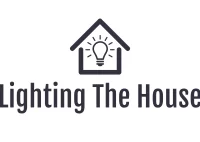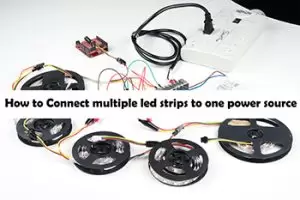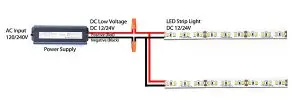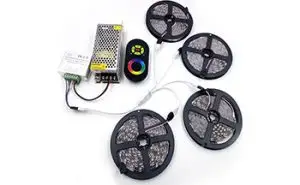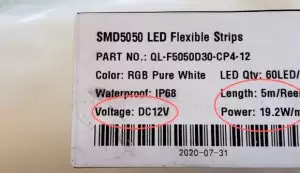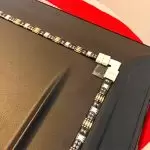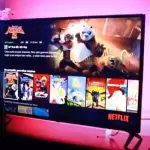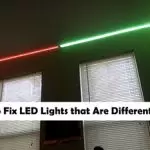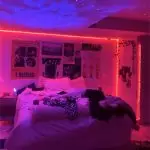You can connect multiple LED strips to one power source in different ways. First, one of the easiest methods is by connecting them in series. Here one strip is directly connected to the main power source and the other strips are connected to the first strip. Next, you can connect them in parallel where both of the strips are connected directly to the main power source.
As the steps are a bit complicated below I’ve explained step by step to-do guide for every method. So let’s learn how to do it.
2 Methods to Connect Multiple LED Strips to One Power Source
If you’re trying to connect multiple LED light strips together to one power source, you can use these two methods – Series & Parallel.
Table of Contents
1. Series
Series connection is the most common method of connecting multiple LED light strips to one power source. Basically, a series connection means connecting several LED light strips to one another. People use connectors or soldering solutions to connect the strips together. Later on, only one LED light strip needs to be connected to the power source & the rest will illuminate through that LED light strip.
One of the major disadvantages of a series connection is if one of the LED light strips becomes faulty – the other strips connected to that particular strip will not illuminate. Because, the current is passing from one LED light strip to another, making them dependent on the strips to supply electricity.
Another drawback of this connection method is – LED lights will continue to dim as the strip length gets longer & longer. Though the electricity level will remain constant in series, the voltage will start to drop continuously & it will cause dimmer LEDs at the ending side of the LED Light strip.
Quick Takeaway: In a series connection, the current level remains constant & voltage changes/drops over time. It causes the ending sides of LED light strips to receive lesser voltage, producing low lighting quality.
Read Also:
How to Cut Led Light Strip Perfectly
How to Connect Led Light Strip With Connector & Soldering
2. Parallel
Parallel LED strip connection refers to connecting multiple LED strips side-by-side, where the positive end of one strip is connected to the positive end of the next strip, and the opposing end of one strip is connected to the negative end of the next strip. This creates multiple independent LED strips that all receive power from one source.
You’ll need to use a device called “LED Light Splitter (Amazon)” to connect your LED light strips to the connector. The other end of the splitter has multiple output ports & you can insert your LED light strips into them. Later on, all you need to do is connect the LED light splitter to the power source. In this way, all the strips will receive the same voltage as it’s very evenly distributed.
The good thing about the parallel connection is – all the LED strips are independent & getting direct power from the power source. That’s why if one LED light strip fails, others won’t be affected by the faulty one.
There is only one drawback of connecting LED light strips in parallel order & that is cable/wire management. Parallel connectivity demands more wire than series & it can be problematic sometimes. Still, parallel connection is the safest & reliable option when it comes to connecting multiple LED light strips to one power source.
Quick Takeaway: In a parallel connection, the voltage level remains constant & current level gets divided by the number of LED Light strips you’re connecting to the power source. It causes all the LED light strips to receive the same electricity amount, producing the same lighting quality.
What’s The Maximum LED Strip Length You Can Have In Power Source
The maximum LED strip length depends on the power source you’re using. The lengthier the strip gets, the more voltage will drop & it will cause low lighting quality if it’s not connected to a proper power source.
Calculating the maximum LED length strip you can have:
Let’s assume you have a 500W 12V power supply unit & you want to know what’s the maximum LED strip length you can have in the power source. Let’s get started:
Most LED strip reels have 16 ft or 5m of LED light strips. Check the voltage; it should be either 12V or 24V. Let’s assume it’s 12V for this example case.
If you check carefully, you’ll notice it’s written how much wattage will 1 meter of LED light strip will consume. Most of the time, it will be 19.2W per meter. So we have the data below:
- PSU: 500W, 12V
- Voltage: 12V
- Reel Length: 5M/Reel
- Wattage Per Meter: 19.2W
Total Wattage Calculation:
5 meters of strips will consume = 5*19.2 or 96W
So, each reel will consume 96W of electricity per hour.
Note: You shouldn’t expect to use PSU to its 100% capacity as it might cause danger. The best practice is to use 80% of the total capacity. This means your 500W power supply unit is safe till (500*80%) 400W.
Total LED Light Strips Length Calculation:
By dividing the total PSU wattage by one reel’s power consumption, you’ll get how many reels you can connect to the PSU. So, it’s – 400/96 or 4.17 ~ 4 reels.
Each reel consists of 16 feet or 5 meters of strips. That means the maximum length of LED strips you can have is 16*4 or 64 feet or 5*4 or 20 meters.
Now, customize the value according to your LED Light strip’s wattage consumption, length & PSU wattage. That’s how you can get your desired answer.
Warning & Precautions
Now you know how to connect multiple led strip lights but as it’s electrical work it can be dangerous for normal people.
For example, soldering isn’t always easy for everyone. There are possibilities you can burn your finger while soldering. So, make sure you are not doing it for the very first time. At least understand the heating mechanism and the proper way to do it.
Again, extra wiring is another challenging task for the newbies. While wiring never keep the power source on. Also, you will have to understand the right terminal for wiring positive and negative. Otherwise, your LED strips won’t even run.
And finally, use glass and gloves for additional safety.
So, Which Method Should You Go for?
A common problem occurs when people don’t understand which method is going for according to their expertise and time. I’ll make sure this won’t happen to you. Below I’m adding a comparison table among the 3 methods. Analyze the table at a glance and you’ll understand which method you should opt for.
| Method/Factors | Difficulty | TIme-consumption | Cost | Expertise |
| Series | Easy | 10-15 minutes | Low | Intermediate |
| Parallel | Hard | 5-10 Minutes | Low | Pro |
I think now you are clear which method is appropriate for you.
Benefits of Connecting Multiple LED Strips to One Power Source
Now let’s come to the benefit of connecting multiple LED strips together. There are mainly 2 benefits of doing it. Let’s learn about them.
Benefit 1: Money Saving
Combining several LED strips with a single power supply can help in lowering energy expenses. As there will require only one outlet for a single power source, you can save money on both energy bills and accessories.
Benefit 2: Easy Decoration Idea
The next benefit is you can use multiple LED strips by combining them together for decoration purposes. Especially if there’s an occasion in the house you can try it and decorate the room in a different way. Moreover, if the LEDs are waterproof then you can also use them outdoors for dedication purposes.
Connecting them together doesn’t cost extra money or time. So you can easily do it.
Conclusion
Now it’s up to you to select the method. If you think here the voltage is very important you don’t want to see any of the strips dim even for a second then go for the parallel method.
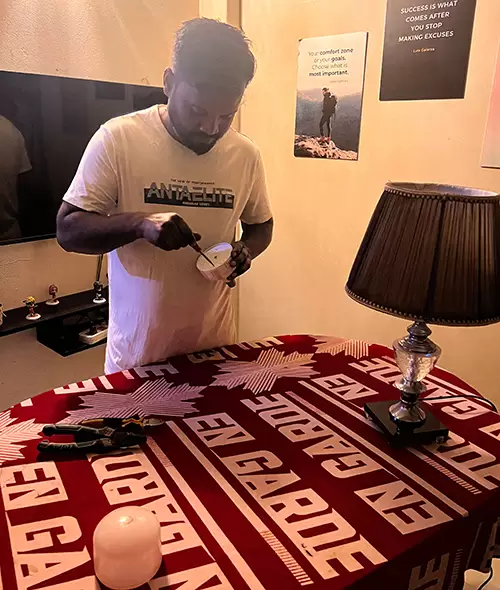
I am Mark Braeden, a professional electrician based in California. With over a decade of experience in the electrical industry, I have launched this website with the aim of sharing my expertise and providing solutions to common lighting issues that can cause frustration for homeowners.
Whether you need help selecting the right bulb for your living room lamp or require guidance in installing LED strip lights, I am here to assist you.
But it’s not just about fixing problems. I’m also here to inspire you with all sorts of creative lighting ideas that can transform your home.
